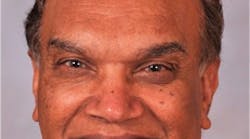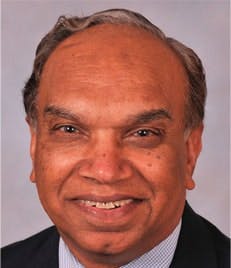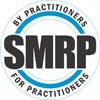Ramesh Gulati is the asset management and reliability planning manager at Arnold Engineering Development Center (AEDC) at Arnold Air Force Base in Tullahoma, TN. He was on the team that developed the CMRP and CMRT exams and is an award-winning author of books on best practices in maintenance and reliability. He recently gave an extended interview to Plant Services.
PS: What did it mean to you to be named SMRP’s CMRP of the Year last year in the Veteran Professional category?
White paper: Lean maintenance – Best practices to turn asset management into a profit center
In this white paper, get actionable insights into areas within the maintenance process where organizations can reduce waste, increase reliability, and view the maintenance effort as an integral part of a lean business posture.
RG: It’s a great honor. I’ve been working in maintenance and reliability and asset management for a long time and with SMRP since 1997-’98, when I was looking for a way to certify our people. We had been doing a lot of training and wanted to test their knowledge. I couldn’t find a way to do that, so I got involved with SMRP.
PS: What do you think prompted your nomination for the CMRP of the Year award?
RG: I think some of my colleagues who put together my application thought I’ve been a big advocate of certification. Really, that’s education. A lot of people come to my class as a kind of preparatory for the CMRP exam, but I tell students, no, I don’t do that, I don’t prepare you for the CMRP exam. I do education; I get you the knowledge on maintenance and reliability and how to do better, what the best practices are. To me, passing the CMRP exam is a byproduct of your knowledge. That’s what really we were doing in our company back in the mid-’90s. We started a lot of training in maintenance and reliability and getting our people education in what best practices are and how to implement them. And then we wanted to know, are they grasping that knowledge or not? And we found the CMRP exam was one way to evaluate whether people were grasping that knowledge.
PS: Can you describe the process of developing the CMRT (Certified Maintenance and Reliability Technician) exam?
RG: It took us (SMRP) almost 4–5 years to develop CMRP, and it got introduced in 2001, but we identified a need for something for our technicians, too. Back in the mid-2000s, ISA, the Instrumentation Society of America, they were asked by their member companies to come up with some kind of a technician-level certification. So they spent a lot of resources in coming up with a certification program for technicians, but they didn’t have the right people or procedures to get that going, so they were looking for somebody who could take the next step. They asked for a few people, and we at SMRP said, hey, we will take over this.
PS: You talk about best practices—how have you seen the definition of that evolve from a maintenance and reliability perspective? Does it encompass more now than it used to?
RG: Best practices is a relative term. I’ll give you an example: the asset management certification process. We implemented it 10 or 12 years ago, but for (those new to the idea), that’s a best practice for them. It reflects a journey. We cannot be standing still. We are always looking for better and better all the time, otherwise you cannot survive. You have to make improvements all the time, continuous improvement. I’ve been involved with ISO 55000, and continuous improvement is key—you need to have it or you cannot survive in today’s environment. Continuous improvement and best practices go together—you’re always looking for how you can make it better. That’s a best practice.
PS: What are some of the biggest stumbling blocks for manufacturers on this journey of continuous improvement?
RG: Most of the time you run into (manufacturers saying): “We are unique. We are different. We make this product; nobody else makes it.” Any place I go—I’ve been to many industrial companies here and there—always people say, “We are unique; no one else is doing this.” You have to get somebody from outside to tell them, “You’re not unique.” The product you make may be unique, but your process is common. What you use—motors, gearboxes, compressors—they may be larger sizes; you may say, “Hey, we’ve got a motor which is large, 10,000 or 30,000 hp, nobody else has it,” but a motor’s a motor. Yes, your product is unique, but the process is the same.
The other (challenge) is getting leadership engaged. A lot of times you hear, “Yeah, we want to do it” because somebody in management goes somewhere, they hear an RCM (reliability-centered maintenance) program, and they come back and say, “Let’s implement an RCM program and take a few dollars for it from here,” but really they don’t have their heart in supporting it. Because all of these best practices—RCM and all other kinds of things—they take time. It’s a long-term effort. It takes a lot of guts. Leadership has to set the example.
When we were trying to implement reliability improvements and in that process educate our workforce and also get them certified, I went to my boss – this was in 2002 or 2003 – who was director of the facility O&M department and had 700 people working for him. He was a good manager and was planning to retire from this job, but I told him, now that we’re implementing all of these reliability improvements and training, I want you to take this CMRP exam. He said, “Are you out of your mind? Get out from my room!” That’s the way his world was. But we started a conversation and talked a few more times, and finally I told him, “You are the leader. You have to show you are leading.” A couple of weeks later, he said, “OK, we will do it.” He took the exam; he and all his managers passed; and that set up the tone. Leadership has to get engaged.
PS: One thing we hear is that practitioners may feel they have had just a title change from maintenance engineer to reliability engineer. Do you find some people are having trouble with what reliability means to them?
RG: Yes, you do see retitling of individuals or departments to reliability or asset management without changing their behavior. I think it’s a leadership issue if many of us don’t understand what reliability is. I was at a reliability conference a couple of years ago and our task was to define – because most of us who are leaders in reliability now came from maintenance – maintenance and reliability and asset management. Before we were involved in maintenance only—day-to-day fixing things. Then came predictive maintenance, and then we learned about reliability, that we have to build reliability into the design. And now, asset management means we have to get maintenance workers involved in the much earlier stages—in the specification, the design, the build, the installation, the commissioning. We have to get involved in all of this, and all have to understand what reliability is.
That’s really what the ISO 55000 standard is, getting more value from your asset. Lately, in the last few years, managers are getting more involved. Leaders are taking a more hands-on role, trying to support this reliability or asset management movement. And they are going to win.
PS: How does the reliability field need to continue to evolve?
RG: Every year there are new buzzwords, but I think with asset management, people are finally realizing, hey, to manage assets is not just maintenance. We have to start working from concept to design and operations and maintenance.
I think our focus should be on before we reach the O&M phase, making sure we are taking care of maintenance and reliability issues during the design, build, installation, and commissioning phases. Taking care also means getting our operators and maintenance guys involved during the pre-operation phase. Hire them six months in advance and let them learn how to operate and maintain (the machines). Let them prepare operations and maintenance instructions, PM plans, et cetera. Then they can teach other people how to do the right thing.
Forty percent of all of our problems are due to operational error. We don’t do the right operational training. Educate (workers); train them. That’s an investment, but that’s a problem we have – we hire people when the equipment is ready to go, and we have no one to operate it.
How do you know that the people you’ve hired are qualified to operate (the equipment)? Advance training helps you solve that problem and lower your total cost of ownership.
I’m working on a book which is based on the concept of total cost of ownership – how are we going to reduce total cost of ownership? And one of the things is, before the O&M phase, yes, we may have to spend a little bit more money during design, fabrication, installation – maybe 10 percent to 30 percent more. But that’s going to reduce the O&M phase cost, and that phase goes on for 25, 35, 50 years.
Awards are presented in two categories: Rising Leader (0–10 years of relevant experience) and Veteran Professional (10-plus years of relevant experience). Winners will be recognized at the SMRP Annual Conference in Cincinnati in October.
We don’t specify right; we don’t know what we want; our requirements are always changing; and then we aren’t happy with it when we get it. Because we don’t get our asset owner-operators involved to figure out what they want and how a given asset should be operating. So then we’re always in trouble.
We spend a lot more money later on but we don’t spend a little bit more money at the beginning. I think that’s a message we have to give: Hey, let’s do a long-term strategy. Reliability is long-term. It’s not short-term.
You hear people talk about operational excellence or continuous improvement – operational excellence is when everyone in the supply chain, in the whole process, whether you are designing or you are building or commissioning or disposing – when everyone in the chain understands their place in the flow. If you’re a sweeper or a lubricator, to understand what value you’re adding by doing the proper application – that by doing that, you’re adding more availability and more profit. Each person needs to understand the value he or she is adding. Like safety, reliability is everyone’s responsibility.


